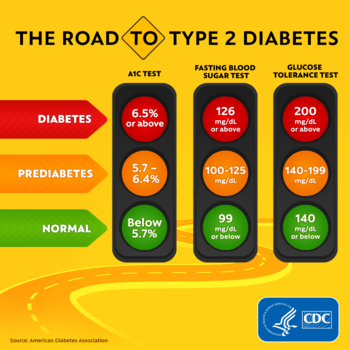The Domino Effect - Obesity, Prediabetes, & Type 2 Diabetes
by Katrina Johnson
December 2020
To stay as healthy as possible, Hettinger and Adams County residents need to understand how excess weight and high blood sugar impacts their health. Over 40% of the U.S. population is obese, increasing risk for cancer, heart attacks, and strokes. Obesity is also associated with prediabetes, a condition that can progress to type 2 diabetes, and may eventually require insulin shots.
“National statistics suggest that about 30% of North Dakotans may have prediabetes.”
Though it's difficult to determine exact numbers, national statistics suggest that about 30% of North Dakotans may have prediabetes. Even more concerning, most of them don't know it. Understanding prediabetes starts with understanding the relationship between sugar and insulin.
 The pancreas, an
organ tucked inside the abdomen, releases a hormone
called insulin. Insulin acts like a key to unlock the
body's cells in order for sugar in the bloodstream from
food consumed, to enter the cells. Being overweight or
obese can contribute to a vicious cycle where this
process fails, resulting in what is referred to as
insulin resistance. When cells don't have the sugar they
need to make energy, the pancreas thinks it needs to make
more insulin. Eventually the pancreas lags behind, unable
to create the supply of insulin for the increased demand.
The result is sugar buildup in the bloodstream. These
early stages of insulin resistance are what define the
beginnings of the reversible condition known as
prediabetes. If enough sugar accumulates in the blood and
surpasses a specific level, the condition is then
referred to as type 2 diabetes.
The pancreas, an
organ tucked inside the abdomen, releases a hormone
called insulin. Insulin acts like a key to unlock the
body's cells in order for sugar in the bloodstream from
food consumed, to enter the cells. Being overweight or
obese can contribute to a vicious cycle where this
process fails, resulting in what is referred to as
insulin resistance. When cells don't have the sugar they
need to make energy, the pancreas thinks it needs to make
more insulin. Eventually the pancreas lags behind, unable
to create the supply of insulin for the increased demand.
The result is sugar buildup in the bloodstream. These
early stages of insulin resistance are what define the
beginnings of the reversible condition known as
prediabetes. If enough sugar accumulates in the blood and
surpasses a specific level, the condition is then
referred to as type 2 diabetes.
Knowing how the pancreas reacts to sugar also provides the information needed to be able to reverse prediabetes and ultimately prevent diabetes. Three specific steps are key and include eating the right amounts of healthy foods, being active, and avoiding cigarettes. Starting with diet, any change may feel like a burden. However, eating the appropriate amounts of healthy foods is actually easier than it might sound.
Counting carbohydrates is an excellent method to keep on track of a healthy diet. Carbohydrates are sugars that naturally occur in most foods and can be found on food nutrition labels. For example, a baked potato is about 15 grams of carbohydrates, or one serving of carbohydrates. For convenience, carb counting apps are also available. If using the carb counting method, the suggested total daily carb count for those people on a standard 1,800 calorie diet will be around 225 carbs. One small change that can be made for those who do not want to learn carbohydrate counting is to prepare meals using a tool called the Plate Method. This involves dividing a regular dinner plate into four equal sections. Two sections are for non-starchy vegetables like salads, broccoli or green beans, one section is for meat or other proteins, like beans or eggs, and the last section is for starchy foods like potatoes or pasta. Meal planning ahead of time is also an effective tool that helps track when, what, and how much is going to be eaten in order to estimate blood sugar levels in advance.
In addition to diet, activity levels are important to keep prediabetes from converting to the more serious diagnosis of diabetes. The American Heart Association's recommends two and a half hours of moderate activity per week. This can be broken down into 30 minutes five days per week of walking, running, shooting hoops, lifting weights, or farming and ranching activities. Comparatively, for some rural North Dakotans during the chilly winter months, this can also be more casually accomplished with just over two 10-minute fast walks seven days per week. Even if that goal is hard to reach initially, it is important to not give up activity altogether. Remember: even a small increase in activity each day can improve health.
A third approach to preventing prediabetes from progressing to full blown diabetes is to eliminate cigarettes. So why does smoking contribute to elevated blood sugar levels when cigarettes aren't even food? Cigarettes contain nicotine and other various chemicals that cause insulin resistance. Nicotine specifically signals the body's cells to ignore the insulin key so sugar can't enter cells. Other chemicals in cigarettes cause the body's cells to become inflamed, again resulting in insulin resistance.
Paying special attention to the big three factors – healthy eating, exercise, and avoiding cigarettes – not only can reverse prediabetes, but can also help prevent diabetes, and prevent or lessen obesity. Implementing change can be difficult, but the journey can begin by making one simple change, leading down an individualized path towards a healthy lifestyle.
This article also appeared in the January 7, 2021 issue of the Adams County Record.
About the Author
 Katrina Johnson is a third-year medical student at
the University of North Dakota School of Medicine &
Health Sciences. She was selected as the Hettinger
participant for the school's ROME program, or Rural
Opportunities in Medical Education. Because the program
includes teaching student doctors about the importance of
rural newspapers in delivering health information, she
has written this column for her ROME community. The
information is not for diagnosis or treatment and should
not be used in place of previous medical advice provided
by a licensed practitioner.
Katrina Johnson is a third-year medical student at
the University of North Dakota School of Medicine &
Health Sciences. She was selected as the Hettinger
participant for the school's ROME program, or Rural
Opportunities in Medical Education. Because the program
includes teaching student doctors about the importance of
rural newspapers in delivering health information, she
has written this column for her ROME community. The
information is not for diagnosis or treatment and should
not be used in place of previous medical advice provided
by a licensed practitioner.
